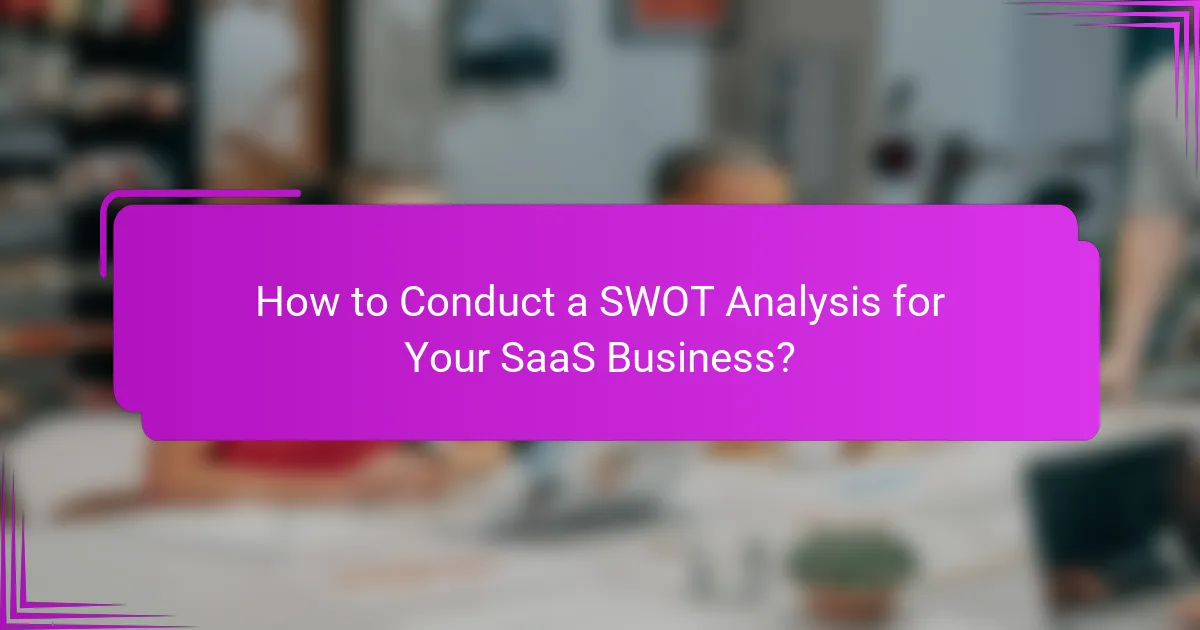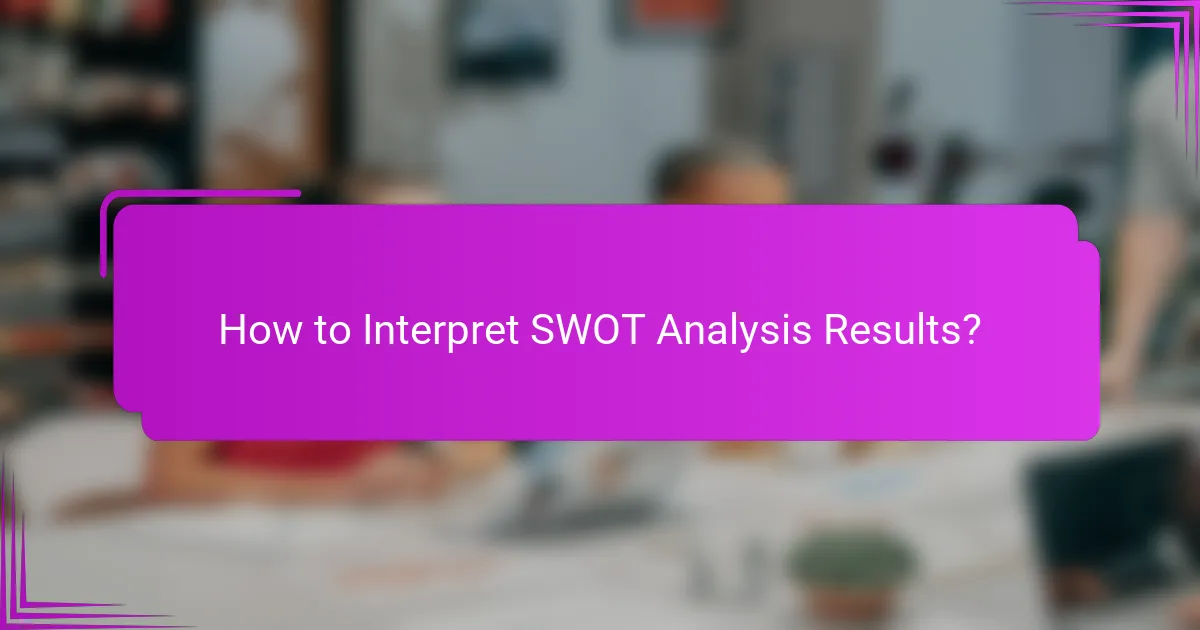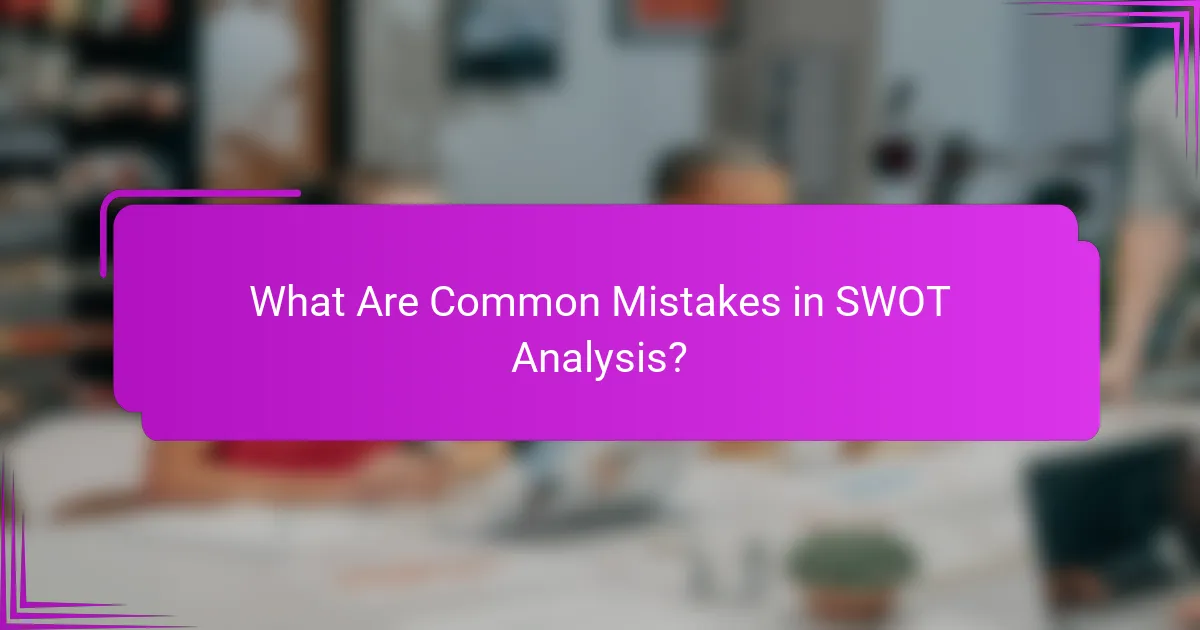SWOT analysis is a powerful tool for businesses, particularly in the SaaS sector, as it systematically evaluates strengths, weaknesses, opportunities, and threats. By understanding these four elements, organizations can enhance their strategic planning and make informed decisions that drive growth and mitigate risks.

How to Conduct a SWOT Analysis for Your SaaS Business?
To conduct a SWOT analysis for your SaaS business, start by identifying your strengths, weaknesses, opportunities, and threats. This structured approach helps you understand your current position and strategize for future growth.
Identify strengths
Begin by listing the unique advantages of your SaaS business. Consider factors like your technology, customer service, brand reputation, and skilled workforce. For example, if your software offers superior user experience or integrates seamlessly with popular platforms, these are significant strengths.
Engage your team in brainstorming sessions to uncover strengths that may not be immediately obvious. This collaborative effort can reveal insights that enhance your competitive edge.
Assess weaknesses
Next, evaluate internal weaknesses that could hinder your business performance. Common weaknesses include limited features, high churn rates, or inadequate marketing strategies. For instance, if your customer support response time is longer than industry standards, this could be a critical weakness.
Be honest and thorough in this assessment, as recognizing weaknesses allows you to develop strategies to mitigate them. Consider gathering feedback from customers to identify areas for improvement.
Explore opportunities
Look for external opportunities that your SaaS business can capitalize on. This might include emerging market trends, technological advancements, or changes in customer behavior. For example, if there’s a growing demand for remote work solutions, your business could develop features that cater to this need.
Stay informed about industry developments and competitor actions to identify potential opportunities. Networking with industry peers can also provide insights into new avenues for growth.
Evaluate threats
Identify external threats that could impact your SaaS business. These may include increasing competition, regulatory changes, or economic downturns. For instance, if a new competitor enters the market with a disruptive pricing model, this could pose a significant threat to your customer base.
Regularly monitor the market landscape to stay ahead of potential threats. Developing contingency plans can help you respond effectively to these challenges.
Compile findings
Finally, compile your findings into a clear, actionable report. Organize the strengths, weaknesses, opportunities, and threats into a matrix format for easy reference. This visual representation can help you prioritize strategies and make informed decisions.
Share the compiled analysis with your team to foster a collective understanding of your business position. Use this document as a living resource, updating it regularly as your business and the market evolve.

What Are the Benefits of SWOT Analysis?
SWOT analysis provides a structured framework for identifying strengths, weaknesses, opportunities, and threats, which can significantly enhance an organization’s strategic planning and decision-making processes. By systematically evaluating these four elements, businesses can develop actionable insights that drive growth and mitigate risks.
Improved strategic planning
SWOT analysis aids in improved strategic planning by clearly outlining internal strengths and weaknesses alongside external opportunities and threats. This comprehensive view allows organizations to align their resources effectively and prioritize initiatives that leverage strengths while addressing weaknesses.
For example, a company may identify its strong brand reputation as a key strength, which can be leveraged to enter new markets. By focusing on these insights, businesses can create more focused and effective strategic plans.
Enhanced decision-making
Enhanced decision-making is another significant benefit of SWOT analysis. By providing a clear picture of the current situation, it helps leaders make informed choices regarding resource allocation, project prioritization, and risk management. This clarity can lead to quicker and more effective decisions.
For instance, if a business identifies a growing market trend as an opportunity, it can quickly decide to invest in product development to capitalize on that trend, rather than hesitating due to uncertainty.
Increased awareness of market position
SWOT analysis increases awareness of a company’s market position by highlighting how it compares to competitors and the overall industry landscape. Understanding these dynamics enables businesses to identify gaps in the market and areas for improvement.
For example, a firm may discover through SWOT that its competitors are offering superior customer service, which could prompt it to enhance its own service offerings to remain competitive. This awareness is crucial for maintaining relevance and achieving long-term success.

What Tools Can Help with SWOT Analysis?
Several tools can enhance your SWOT analysis by providing structure, facilitating collaboration, and offering data insights. Utilizing templates, online collaboration platforms, and business intelligence software can streamline the process and improve outcomes.
SWOT analysis templates
SWOT analysis templates are pre-designed frameworks that help organize your strengths, weaknesses, opportunities, and threats. These templates can be found in various formats, including spreadsheets, documents, and presentation slides, making them versatile for different uses.
When selecting a template, consider your specific needs. Some templates are simple and straightforward, while others may include prompts or examples to guide your analysis. Look for templates that allow for easy customization to fit your unique situation.
Online collaboration tools
Online collaboration tools enable teams to work together on SWOT analysis in real-time, regardless of their physical location. Platforms like Google Workspace, Microsoft Teams, and Miro provide shared spaces where team members can contribute ideas and insights simultaneously.
To maximize effectiveness, choose tools that offer features such as commenting, version control, and integration with other applications. This ensures that all team members can stay updated and engaged throughout the analysis process.
Business intelligence software
Business intelligence software can enhance your SWOT analysis by providing data-driven insights into market trends, competitor performance, and internal metrics. Tools like Tableau, Power BI, and QlikSense allow users to visualize data, making it easier to identify strengths and weaknesses.
When using business intelligence software, focus on key performance indicators (KPIs) relevant to your analysis. This will help you draw meaningful conclusions and make informed decisions based on the data collected. Ensure that the software you choose is user-friendly and aligns with your team’s skill level.

How to Interpret SWOT Analysis Results?
Interpreting SWOT analysis results involves understanding the strengths, weaknesses, opportunities, and threats identified in the assessment. This process helps organizations make informed decisions by leveraging their strengths and opportunities while addressing weaknesses and mitigating threats.
Identify actionable insights
To identify actionable insights from a SWOT analysis, focus on translating findings into specific actions. For instance, if a strength is a strong brand reputation, consider strategies to enhance brand loyalty or expand into new markets. Conversely, if a weakness is limited online presence, prioritize digital marketing initiatives.
Use a matrix to map insights against potential actions. This can help visualize which strengths can be leveraged for opportunities or which weaknesses need urgent attention. Regularly revisiting these insights ensures they remain relevant as market conditions change.
Prioritize strategic initiatives
Prioritizing strategic initiatives based on SWOT analysis results requires evaluating the potential impact and feasibility of each action. Start by ranking initiatives that leverage strengths to seize opportunities, as these often yield the highest returns. For example, if a company has a strong product line and identifies a growing market trend, launching a targeted marketing campaign should be a priority.
Consider using a scoring system to assess initiatives on criteria such as cost, time to implement, and expected outcomes. This structured approach helps avoid common pitfalls, such as spreading resources too thin across multiple initiatives. Focus on a few high-impact strategies to maximize effectiveness and ensure successful execution.

What Are Common Mistakes in SWOT Analysis?
Common mistakes in SWOT analysis include failing to consider external factors, being overly vague in assessments, and neglecting team input. These pitfalls can lead to incomplete or inaccurate evaluations, ultimately undermining strategic planning.
Overlooking external factors
One significant mistake in SWOT analysis is overlooking external factors that can impact an organization. This includes market trends, economic conditions, and competitor actions. Failing to account for these elements can result in a skewed understanding of strengths and weaknesses.
To avoid this, regularly review industry reports and conduct market research. This helps ensure that your analysis reflects the current landscape, allowing for more informed decision-making.
Being too vague
Another common error is being too vague in identifying strengths, weaknesses, opportunities, and threats. Generic statements like “we have a good product” do not provide actionable insights. Specificity is crucial for effective strategy development.
Instead, focus on concrete examples and measurable attributes. For instance, rather than stating “strong brand,” specify metrics such as market share or customer loyalty scores. This clarity aids in prioritizing actions and resources effectively.
Ignoring team input
Ignoring team input can significantly weaken the SWOT analysis process. Team members often have valuable insights based on their experiences and expertise. Excluding their perspectives can lead to missed opportunities and unrecognized threats.
Encourage collaboration by holding workshops or brainstorming sessions. This inclusive approach not only enriches the analysis but also fosters a sense of ownership among team members, enhancing commitment to the resulting strategies.
